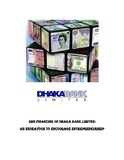| dc.description.abstract | customers having enough resources that could easily provide adequate coverage of the exposure through offering high value security. A substantial portion of bank’s lending was thus security oriented and that too to a few large and corporate clients. But experience with large customers was not that much pleasant as was thought to be. So changes in the concept of bank’s lending became necessary. Financing in Small & Medium Enterprises (SME) have become a major focus of the commercial banks as an effective means of stimulating economic activity for overall development of a country like Bangladesh. Dhaka Bank Limited is pretty aware of this lending concept and has already stepped into the field by extending finance to this sector. From the very beginning of its inception, DBL is endeavoring to encourage entrepreneurship within the country. This report is a small attempt to focus on that endeavor DBL has adopted to encourage entrepreneurship. The report consists seven chapters. Chapter one talks about the origin, objective, scope, methodology and limitations of the report. In chapter two, the author has briefly discussed about Dhaka Bank Limited’s Historical Perspective, Mission & Vision, Goals of the Bank, Values, Objectives of the Bank, Management System, Correspondent Relationship, Departments of DBL, Current Performance, Policies and Strategies of the bank, Environment of Dhaka bank, Corporate Banking, Banking System and Financial Structure In Bangladesh, Commercial Banking in Bangladesh, SWOT Analysis of Dhaka Bank Limited, Credit rating report of Dhaka bank limited. Chapter three consists of the working experience of the author in different departments. The whole SME financing, Product Program Guide under DBL SME Financing where the author discussed about the types of facilities under DBL SME and their features, eligibility criteria to enjoy the facilities, customer segments, purpose for DBL SME financing, restricted areas under SME Financing etc. SME loans and advances procedure has been discussed in chapter four. Each and every step from loan application receiving to loan disbursal and loan recovery has been elaborately described in this chapter also DBL SME Financing Scenario in recent years. Chapter five contains findings and analysis of the study respectively. Finally, the author has made her recommendations and conclusion in chapter six and seven respectively. Several suggestions to develop the SME Financing System of Dhaka Bank Limited have been given in this part. | en_US |

